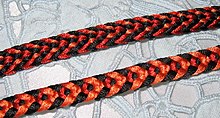This article possibly contains original research. (July 2023) |


Kumihimo (組み紐) is a traditional Japanese artform and craftwork for making braids and cords.[1][2] In the past, kumihimo decorations were used as accessories for kimono as well as samurai armor.[3] Japanese braiding, as kumihimo is sometimes known in English, is also associated with Shinto rituals and religious services.[2] Literally meaning "gathered threads", kumihimo are made by interlacing reels of yarn, commonly silk, with the use of traditional, specialised looms – either a marudai (丸台, lit. 'round stand')[2] or a takadai (高台) (also known as a kōdai).
There are a number of different styles of kumihimo weaving, which variously create a braided cord ranging from very flat to almost entirely rounded.[1] Kumihimo cords are used as obijime, cords worn belted around the front of some obi when wearing kimono.
- ^ a b Kinoshita, Masako (1986). "A Braiding Technique Documented in an Early Nineteenth-Century Japanese Treatise" Soshun Bik‾"". Textile Museum Journal. 25: 47–65 – via EBSCOhost Art & Architecture Source.
- ^ a b c Kimura, Akiko; Tada, Makiko; Uozumi, Tadashi; Goto, Akihiko (2018), Trzcielinski, Stefan (ed.), "Teaching Method of Technique to Make the Braiding", Advances in Ergonomics of Manufacturing: Managing the Enterprise of the Future, vol. 606, Cham: Springer International Publishing, pp. 310–321, doi:10.1007/978-3-319-60474-9_29, ISBN 978-3-319-60473-2, retrieved 2024-07-09
- ^ Duffy, Vincent G. (2016-07-04). Digital Human Modeling: Applications in Health, Safety, Ergonomics and Risk Management: 7th International Conference, DHM 2016, Held as Part of HCI International 2016, Toronto, ON, Canada, July 17-22, 2016, Proceedings. Springer. pp. 132–133. ISBN 978-3-319-40247-5.